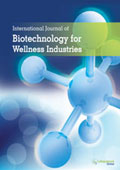ijbwi
|
|
Abstract: Microbial fermentation for bio-based products is quickly becoming an integral component of the world infrastructure, as the processes encompassing the synthesis of these natural products becomes more efficient and cost effective to compete with existing commodities. Bioethanol is currently one of the most desired fermentation products, as this constituent can be applied to multiple uses in not only contributing to the more traditional routes of beer brewing and winemaking, but also in the foundation for green fuel sources. By optimizing yields, the innovative processes could be applied towards engineering more rapid and productive biomanufacturing. In order to achieve these goals, we as researchers must understand the underlying principles and intricate networks that play a role within the microenvironment and also on the cellular level in key fermentative microbes such as Saccharomyces cerevisiae and Zymomonas mobilis. In-depth pathway analysis could lead to the development of more favorable metabolic outcomes. This review focuses on the key metabolic networks and cellular frameworks in these model organisms, and how biosynthesis of ethanol yields can be optimized throughout the fermentation process. Keywords: Bioethanol, Biofuel, Saccharomyces cerevisiae, Zymomonas mobilis.Download Full Article |
|
|
Abstract: Mangosteen rind (MSR) (Garcinia mangostana L.) is a predominant component of the fruit contributing to 62% of the whole fruit. However, utilization of the same for the preparation of health products was not explored due to its sensorially less acceptable parameters. Differential extraction in different polarity solvents of MSR was done and evaluated their acceptability for product preparation.Current study thus is a detailed investigation on bioactivity profiling of MSR fraction and utilization of the same for health product preparation. Among various extracts, 70% ethanol (70%AE) yielded the maximum (15g/100g). Xanthone:Phenolic ratio was 1: 2.8, in 70%AE as opposed to hot water extract – HWE and 50% AE, which contained Xanthone:Phenolic ratio of 1:1.4/5. Higher the phenolic content obviously reduces the bitterness of Xanthones. 70% AE contained phenolics 60.08± 0.213 mg/g and xanthones 22.56± 0.317 mg/g. HPLC analysis revealed a spectrum of phenolic acids such as gallic, chlorogenic, caffeic, epicatechin, catechin and ferulic acids at various levels. Potent Free Radical Scavenging (FRS) activity, cytoprotectivity, DNA protectivity, H+K+ATPase inhibitory (PPAI) activities were observed in 70% AE. Gallic/tannic acid appear to contribute to antioxidant activity; while ferulic acid was responsible for PPAI activity in 70%AE. Among xanthones, although α- mangostin was the dominating component, gartanin, 8 deoxygartanin and 3-isomangostin contributed to FRS activity. The products were prepared from 70%AE which are sensorially acceptable. Data thus for the first time delineate the specific health beneficial role of both phenolic and xanthone constituents in MSR particularly with higher abundance of phenolics than xanthones. Keywords: Phenolic, Xanthone, Garcinia mangostana L., Free Radical Scavenging, Cyto/DNA.Download Full Article |
|
|
Abstract: Acanthamoeba Keratitis is an important corneal infection that caused impaired vision. The Universiti Malaysia Terengganu (UMT) researcher found new species of Acanthamoeba that was being isolated from eye infection in Hospital Kuala Lumpur, which have the characteristic between Acanthamoeba polyphaga and A. castellanii named as HKL-Acantha. This study was aimed to generate specific monoclonal antibody against HKL-Acantha that eventually could be used in diagnosing eye infection among Malaysian.Two Balb/c mice were immunized with sonicated HKL-Acantha through intraperitoneal injection, and anti HKL-acantha IgG, IgM, IgA were measured using ELISA test. Sera from infected mice showed detectable anti-HKL-acantha IgM. The spleen from animal with high antibody titer around (1:81000) was used as a partner in fusion with SP2/0-Ag14 myeloma cells to produce new hybridoma cells, which were then selected and cloned using the selection medium. Two positive hybridoma clones secreting IgM antibodies were obtained and named as hybridoma UTM-Ha1 and UTM-Ha2. Both clones were secreting monoclonal IgM antibody specific to HKL-Acantha. This study suggests the potential of both hybridomas UTM-Ha1 and UTM-Ha2 to generate specific monoclonal IgM against HKL-acantha. This newly generated monoclonal IgM could be used to diagnose the presence of HKL- acantha in patients with eye infection in future. Keywords: Acanthameoba, corneal infection, HKL-Acantha, UTM-Ha1, UTM-Ha2.Download Full Article |
|
|
Abstract: The ability of three freshwater microalgae strains, namely Chlaorella sp., Pseudochlorococcum sp. and Chlamydomonas sp. to grow in water containing different concentrations of phenol has been tested. The effectiveness of the selected strains to utilize the phenol as a carbon source and reduce its concentration has also been assessed. The phenol removal efficiency and cells growth rates were evaluated at different initial phenol concentrations, in the range of 100-450 ppm. It was found that growing, under a reduced illumination condition, increased the inhibition onset concentration, enhanced the phenol removal and allowed the strains to tolerate higher phenol concentrations reaching 450 ppm. In the tested range of the phenol concentrations, Chlamydomonas sp. has shown to have the highest specific growth rate of 0.59 day-1, whereas Pseudochlorococcum sp showed the highest phenol removal rate of 166 ppm day-1. Three kinetics models that incorporate substrate inhibition were tested to describe the growth, which show almost identical fittings. Keywords: Microalgae, Phenol bioremediation, Wastewater treatment, Growth kinetics, Substrate Inhibition, Light limitation.Download Full Article |




